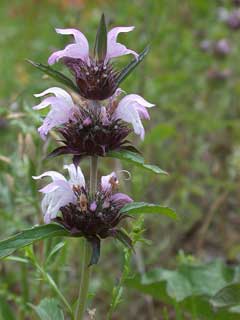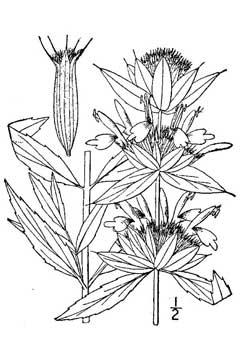 |
|
www.flickr.com/photos/51035796522@N01 |
 |
| USDA-NRCS PLANTS Database / Britton, N.L., and A. Brown. 1913. An illustrated flora of the northern United States, Canada and the British Possessions. 3 vols. Charles Scribner's Sons, New York. Vol. 3 |
Translate this page:
Summary
Physical Characteristics

 Monarda pectinata is a ANNUAL/PERENNIAL growing to 1 m (3ft 3in). The species is hermaphrodite (has both male and female organs) and is pollinated by Bees. The plant is self-fertile.
Monarda pectinata is a ANNUAL/PERENNIAL growing to 1 m (3ft 3in). The species is hermaphrodite (has both male and female organs) and is pollinated by Bees. The plant is self-fertile.
It is noted for attracting wildlife.
Suitable for: light (sandy), medium (loamy) and heavy (clay) soils, prefers well-drained soil and can grow in heavy clay soil. Suitable pH: mildly acid, neutral and basic (mildly alkaline) soils. It cannot grow in the shade. It prefers dry or moist soil.
UK Hardiness Map
US Hardiness Map
Synonyms
Plant Habitats
Cultivated Beds;
Edible Uses
Edible Parts: Leaves
Edible Uses: Condiment Tea
Leaves - cooked. A strong aromatic flavour, they are used as a flavouring in cooked foods and salads[61, 161].
References More on Edible Uses
Medicinal Uses
Plants For A Future can not take any responsibility for any adverse effects from the use of plants. Always seek advice from a professional before using a plant medicinally.
Anodyne Antiseptic Febrifuge Stings Stomachic
The plant is analgesic, antiseptic and stomachic[257]. An infusion has been used in the treatment of coughs, colds, fevers and stomach complaints[257]. The plant has been rubbed on the head to bring relief from headache[257]. An infusion of the flowers has been used as a wash on insect bites and stings[257].
References More on Medicinal Uses
The Bookshop: Edible Plant Books
Our Latest books on Perennial Plants For Food Forests and Permaculture Gardens in paperback or digital formats.

Edible Tropical Plants
Food Forest Plants for Hotter Conditions: 250+ Plants For Tropical Food Forests & Permaculture Gardens.
More

Edible Temperate Plants
Plants for Your Food Forest: 500 Plants for Temperate Food Forests & Permaculture Gardens.
More

More Books
PFAF have eight books available in paperback and digital formats. Browse the shop for more information.
Shop Now
Other Uses
References More on Other Uses
Cultivation details
Easily grown in ordinary garden soil so long as it is not too dry[1, 200], though it prefers a sandy rather acidic soil in full sun[200]. There is some confusion over the correct name for this species, some reports say that it is no more than a synonym for M. citriodora[183]. There is also some doubt over whether it is an annual or a perennial. A good bee plant[200]. Subject to mildew in dry summers[200].
References Carbon Farming Information and Carbon Sequestration Information
Temperature Converter
Type a value in the Celsius field to convert the value to Fahrenheit:
Fahrenheit:
The PFAF Bookshop
Plants For A Future have a number of books available in paperback and digital form. Book titles include Edible Plants, Edible Perennials, Edible Trees,Edible Shrubs, Woodland Gardening, and Temperate Food Forest Plants. Our new book is Food Forest Plants For Hotter Conditions (Tropical and Sub-Tropical).
Shop Now
Plant Propagation
Seed - sow mid to late spring in a cold frame. Germination usually takes place within 10 - 40 days at 20°c. When large enough to handle, prick the seedlings out into individual pots and plant them out into their permanent positions in early summer. The seed can also be sown in situ in late summer in areas where the winters are not too severe and will produce larger plants. Cuttings of soft basal shoots in spring. Harvest the shoots with plenty of underground stem when they are about 8 - 10cm above the ground. Pot them up into individual pots and keep them in light shade in a cold frame or greenhouse until they are rooting well. Plant them out in the summer. Division in spring or autumn. Large divisions can be planted out direct into their permanent positions. We have found that it is better to pot up the smaller divisions and grow them on in light shade in a cold frame until they are well established before planting them out in late spring or early summer.
Other Names
If available other names are mentioned here
Native Range
NORTHERN AMERICA: United States (Kansas (west), Nebraska, South Dakota (s.-c.), Oklahoma (west), Colorado, New Mexico, Texas, Arizona, California (southeast), Utah (south)), Mexico (north)
Weed Potential
Right plant wrong place. We are currently updating this section.
Please note that a plant may be invasive in one area but may not in your area so it's worth checking.
Conservation Status
IUCN Red List of Threatened Plants Status :

| Related Plants
|
| Latin Name | Common Name | Habit | Height | Hardiness | Growth | Soil | Shade | Moisture | Edible | Medicinal | Other |
| Monarda citriodora | Lemon Bergamot, Lemon beebalm. Lemon Mint | Annual/Perennial | 0.6 |
5-9
| F | LMH | SN | M | 2 | 0 | 3 |
| Monarda clinopodia | White Basil-Balm, White bergamot | Perennial | 1.3 |
4-8
| | LMH | SN | M | 1 | 0 | |
| Monarda didyma | Bergamot, Scarlet beebalm, Horsemint, Oswego Tea, Bee Balm | Perennial | 0.9 |
4-10
| M | LMH | SN | M | 3 | 2 | 3 |
| Monarda fistulosa | Wild Bergamot, Mintleaf bergamot, Wild Bee-Balm, Lupine | Perennial | 1.5 |
4-10
| M | LMH | N | DM | 3 | 2 | 2 |
| Monarda menthifolia | Mint-Leaved Bergamot, Mintleaf bergamot | Perennial | 0.8 |
3-7
| | LMH | SN | M | 1 | 2 | |
| Monarda punctata | Horse Mint, Spotted beebalm | Annual/Perennial | 0.8 |
5-9
| | LMH | SN | DM | 1 | 3 | 1 |
|
Growth: S = slow M = medium F = fast. Soil: L = light (sandy) M = medium H = heavy (clay). pH: A = acid N = neutral B = basic (alkaline). Shade: F = full shade S = semi-shade N = no shade. Moisture: D = dry M = Moist We = wet Wa = water.
Now available:
Food Forest Plants for Mediterranean Conditions
350+ Perennial Plants For Mediterranean and Drier Food Forests and Permaculture Gardens.
[Paperback and eBook]
This is the third in Plants For A Future's series of plant guides for food forests tailored to
specific climate zones. Following volumes on temperate and tropical ecosystems, this book focuses
on species suited to Mediterranean conditions—regions with hot, dry summers and cool, wet winters,
often facing the added challenge of climate change.
Read More
Expert comment
Author
Nutt.
Botanical References
43200
Links / References
For a list of references used on this page please go here
Readers comment
| Add a comment |
|
If you have important information about this plant that may help other users please add a comment or link below. Only comments or links that are felt to be directly relevant to a plant will be included. If you think a comment/link or information contained on this page is inaccurate or misleading we would welcome your feedback at [email protected]. If you have questions about a plant please use the Forum on this website as we do not have the resources to answer questions ourselves.
* Please note: the comments by website users are not necessarily those held by PFAF and may give misleading or inaccurate information.
To leave a comment please Register or login here All comments need to be approved so will not appear immediately.
|
Subject : Monarda pectinata
|
|
|
|